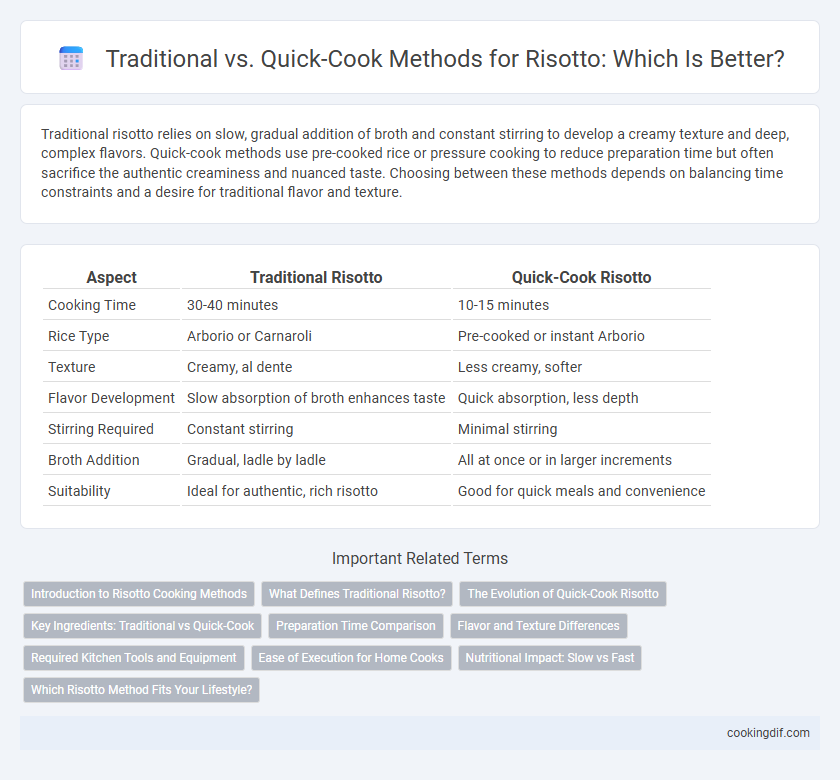Traditional risotto relies on slow, gradual addition of broth and constant stirring to develop a creamy texture and deep, complex flavors. Quick-cook methods use pre-cooked rice or pressure cooking to reduce preparation time but often sacrifice the authentic creaminess and nuanced taste. Choosing between these methods depends on balancing time constraints and a desire for traditional flavor and texture.
Table of Comparison
| Aspect | Traditional Risotto | Quick-Cook Risotto |
|---|---|---|
| Cooking Time | 30-40 minutes | 10-15 minutes |
| Rice Type | Arborio or Carnaroli | Pre-cooked or instant Arborio |
| Texture | Creamy, al dente | Less creamy, softer |
| Flavor Development | Slow absorption of broth enhances taste | Quick absorption, less depth |
| Stirring Required | Constant stirring | Minimal stirring |
| Broth Addition | Gradual, ladle by ladle | All at once or in larger increments |
| Suitability | Ideal for authentic, rich risotto | Good for quick meals and convenience |
Introduction to Risotto Cooking Methods
Traditional risotto preparation involves slowly simmering arborio or carnaroli rice in broth while continuously stirring, which develops a creamy texture through gradual starch release. Quick-cook risottos utilize pre-cooked or processed rice varieties, reducing cooking time but often resulting in less depth of flavor and texture. Understanding these methods helps home cooks balance authenticity with convenience.
What Defines Traditional Risotto?
Traditional risotto is defined by its slow cooking process, where Arborio or Carnaroli rice is gradually simmered in broth while being continuously stirred to release the starches, creating a creamy texture. The procedure relies on patience and careful attention, incorporating ingredients such as sauteed onions, white wine, and freshly grated Parmesan cheese for depth of flavor. This method differs significantly from quick-cook risotto, which uses pre-cooked rice or pressure cooking, sacrificing the authentic silky consistency and nuanced taste achieved through the classic technique.
The Evolution of Quick-Cook Risotto
Quick-cook risotto methods have evolved to simplify the traditional slow-stirring process by using pre-toasted Arborio rice and pressure cooking techniques, significantly reducing preparation time while maintaining creamy texture. Innovations in quick-cook risotto often incorporate flavor-infused broths and pre-measured ingredients, ensuring consistent results without sacrificing authenticity. These advancements cater to modern lifestyles by delivering the hallmark creaminess and depth of traditional risotto in a fraction of the time required by classic stovetop methods.
Key Ingredients: Traditional vs Quick-Cook
Traditional risotto relies on arborio or carnaroli rice varieties, slowly cooked with broth and enriched with ingredients like Parmesan cheese, butter, and onions to achieve a creamy texture. Quick-cook versions often use pre-cooked or parboiled rice, reducing cooking time but sometimes sacrificing the depth of flavor and texture that slow simmering imparts. Key ingredients in traditional methods emphasize gradual absorption of stock and continuous stirring, while quick-cook alternatives prioritize convenience with simplified seasoning and faster preparation.
Preparation Time Comparison
Traditional risotto preparation typically requires 30 to 45 minutes, involving gradual addition of broth and constant stirring to achieve creamy texture. Quick-cook risotto methods reduce cooking time to about 10 to 15 minutes by using pre-cooked or instant rice varieties and broth mixtures. The time saved with quick-cook methods often trades off the depth of flavor and texture characteristic of traditional risotto.
Flavor and Texture Differences
Traditional risotto, cooked slowly by gradually adding warm broth and frequent stirring, develops a creamy texture with rice grains that are tender yet slightly firm to the bite, enhancing complex, deep flavors from caramelized onions and toasted Arborio rice. Quick-cook methods use pre-cooked or pressure-cooked rice, resulting in a less creamy, often mushier texture and a milder flavor profile due to reduced time for starch release and flavor melding. The traditional method ensures optimal integration of ingredients and a richer taste experience that quick-cook cannot fully replicate.
Required Kitchen Tools and Equipment
Traditional risotto requires a heavy-bottomed pan or wide saute pan for even heat distribution, a wooden spoon for constant stirring, and a ladle for gradually adding warm broth, ensuring creamy texture development. Quick-cook risotto methods often utilize non-stick skillets or multi-cookers like Instant Pots, minimizing stirring and reducing cooking time with built-in temperature control. Both methods benefit from a good chef's knife for prepping ingredients and a measuring cup for precise broth addition.
Ease of Execution for Home Cooks
Traditional risotto preparation involves slow, gradual addition of hot broth while continuously stirring, demanding patience and attention to achieve a creamy texture and deeply developed flavors. Quick-cook methods utilize pre-cooked or instant rice varieties, significantly reducing cooking time and minimizing the need for constant stirring, making the dish more accessible to home cooks with limited time. Choosing between methods depends on balancing desired texture authenticity with ease of execution in a home kitchen setting.
Nutritional Impact: Slow vs Fast
Traditional slow-cook risotto retains more nutrients by allowing gradual absorption of liquids, preserving vitamins like B-complex and minerals within the rice and broth. Quick-cook methods often involve pre-cooked or instant rice, which can result in nutrient loss due to processing and shorter cooking times. Slow cooking also enhances the bioavailability of antioxidants from added ingredients, contributing to a healthier, more nutrient-rich dish.
Which Risotto Method Fits Your Lifestyle?
Traditional risotto requires constant stirring and gradual addition of broth, creating a creamy texture and rich flavor ideal for those with time to savor cooking. Quick-cook risotto methods use pre-cooked rice or pressure cookers, reducing preparation time drastically, making them perfect for busy lifestyles. Choosing the right risotto method depends on prioritizing either authentic texture or time efficiency.
Traditional vs quick-cook for method Infographic

 cookingdif.com
cookingdif.com